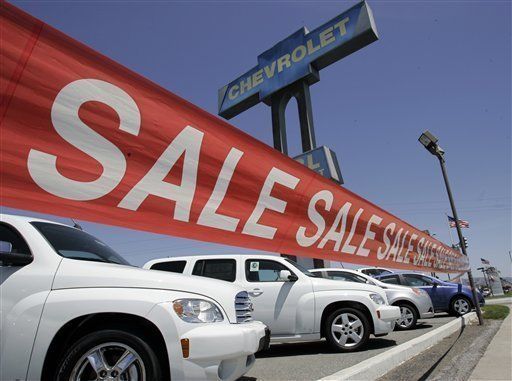
The government is about to go into deja-vu-all-over-again mode -- again -- when it comes to automotive efficiency and, very importantly now, global environmental health and well being.
In the '50s, '60s and '70s, American car makers and the government didn't take the Japanese seriously with their funny little, cheap-to-run, quality cars. Ditto with the Koreans when they showed up later, and ditto again when Toyota and Honda launched their hybrids in the last decade.
Now it's happening again: Barely in office, DoE secretary Steven Chu, a Nobel-Prize winning physicist, in his 2010 budget request wants to zero out the department's successful, relatively well-funded and well-working hydrogen and fuel cell program. He wants to cut it down to a bare-bones research effort, in sync with recommendations from a couple of well-meaning but blinkered, well plugged-in (pun intended) Washington plug-in hybrid zealots named Joseph Romm and James Woolsey. Romm is a physicist, a former high DoE official and now editor of the blog "ClimateProgress.org." Woolsey is a former head of the CIA and advised John McCain on energy policy during the last presidential campaign. Both were part of the Clinton administration.
Chu, Romm, Woolsey and others argue that plug-in hybrids are much closer to reality and a much better near-term technology to deal with climate issues than hydrogen and fuel cell cars. This is highly debatable, the Obama commitment to large federal incentives to get lots of plug-in hybrids on the road in six years notwithstanding: A Toyota executive was quoted in a May 18 Bloomberg story as saying while there will be a market for plug-in hybrids, demand may be limited by price, recharge time and battery durability. Sales may reach 50,000 units/year at most and could be as low as 3,500 units, Bill Reinert, Toyota's national advanced technology manager told a National Academy of Science panel in Washington.
The major car makers, the guys who will have to actually build clean cars in large numbers to a) make a living and b) make a long-term difference in alleviating global warming, are largely ignoring the plug-in dogmatists: Major car makers Honda, Toyota, and Daimler are continuing to develop hydrogen fuel cell cars for the market, said a May 11 Bloomberg story -- a few days after Secretary Chu announced his plans to gut DoE's hydrogen and fuel cell program. Germany's Daimler wants to start production this summer, and Toyota said it will start in 2015, maybe as early as 2014.
GM wants to move ahead on fuel cells as well with its large, 20-year-old, $1 billion program -- government money or not (Other than what seemed to have been relatively small bucks in the early '90s when GM acquired fuel cell technology from Los Alamos National Laboratory, GM never took DoE money for fuel cell r&d but still participates in DoE demo programs) -- but there is that pesky potential bankruptcy problem.
Sandy Thomas, a former aide to Sen. Tom Harkin with a Ph.D. in electrical engineering and now the president of H2Gen, a maker of advanced hydrogen generation equipment in Alexandria, VA, has worked up a fascinating, instructive side-by-side comparison of the current status of fuel cell and plug-in hybrids. (The initial reduction in greenhouse gases per vehicle is about the same for both categories -- 46% -- according to Argonne National Laboratory and cited by Thomas):
How many manufacturer-built (as opposed to retrofits or inventor-builts, for example) vehicles are actually on the road?
Fuel cell vehicles: 318 world wide (Honda and Kia have plans for leasing or making available another 300 over the next three years, according to an internal GM document).
Plug-in vehicles: zero (from major manufacturers. Some aftermarket firms have retrofitted commercial hybrids by adding batteries to provide plug-in capability, according to Thomas)
How many vehicles made by manufacturers have been placed on American roads, with performance monitored by a U.S. national laboratory?
Fuel cells: 140.
Plug-in hybrids: zero.
How many miles have vehicles traveled in this real-life evaluation program?
Fuel cells: 1.92 million miles.
Plug-in hybrids: zero.
According to MIT, how much more would they cost consumers in mass production compared to regular gasoline cars (Fuel cell vehicles with 350 mile range, plug-in hybrids with 30 miles all-electric range)?
Fuel cells: $5,040
Plug-in hybrids: $6,020
According to Argonne National Laboratory, how much would these vehicles reduce oil consumption compared to regular cars?
Fuel cells: 100%
Plug-in hybrids: 60%
And finally, how much would the hydrogen fueling infrastructure for fuel cell vehicles and the electrical charging outlets for plug-in hybrids cost, respectively, according to the National Academy of Sciences (for fuel cell vehicles) and Idaho National Laboratory (for plug-in hybrids)?
Fuel cells: $955/vehicle
Plug-in hybrids: $878 to $2,150/vehicle.
OK. Enough. It seems the United States is once again proudly poised to slip behind. Bottom line: Ten, 15 years down the road, the National Commentariat will once again wring hands collectively and lament in blistering j'accuse prose, "how could we let the Japanese and the Germans and the Koreans (and maybe the Chinese by then), get ahead of us? Didn't anybody see this coming in 2009?" (Of course some saw it, but just not the folks in command).